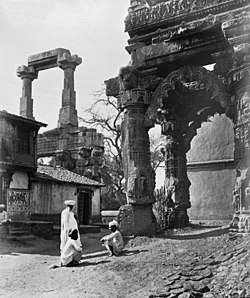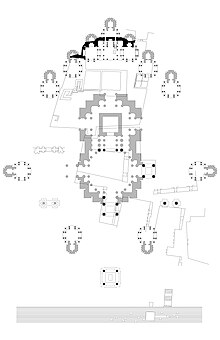| Rudra Mahalaya Temple | |||||||||||||||
|---|---|---|---|---|---|---|---|---|---|---|---|---|---|---|---|
 Ruins of main portal, Toran, of Rudra Mahalaya, 1874 | |||||||||||||||
| Alternative names | Rudra Mala | ||||||||||||||
| General information | |||||||||||||||
| Status | ruined | ||||||||||||||
| Architectural style | Māru-Gurjara architecture | ||||||||||||||
| Location | Siddhpur, Patan district, Gujarat | ||||||||||||||
| Country | India | ||||||||||||||
| Coordinates | 23°55′09″N 72°22′45″E / 23.91917°N 72.37917°E | ||||||||||||||
| Construction started | 943 CE | ||||||||||||||
| Opened | 1140 CE | ||||||||||||||
| Destroyed | 1296 CE and 1414 CE | ||||||||||||||
| Technical details | |||||||||||||||
| Material | sandstone | ||||||||||||||
| Floor count | 2 | ||||||||||||||
| Designations | ASI Monument of National Importance (N-GJ-164 for temple/163 for mosque) | ||||||||||||||
| |||||||||||||||
The Rudra Mahalaya Temple, also known as Rudramal, is a destroyed/desecrated Hindu temple complex at Siddhpur in the Patan district of Gujarat, India. Its construction was started in 943 CE by Mularaja and completed in 1140 CE by Jayasimha Siddharaja, a ruler of the Chaulukya dynasty. The Hindu temple was destroyed by the Sultan of Delhi, Alauddin Khalji, and later the Sultan of Gujarat, Ahmed Shah I (1410–1444) desecrated and substantially demolished the temple, and also converted part of it into the congregational mosque (Jami Masjid) of the city. Two torans (porches) and four pillars of the former central structure still stand along with the western part of the complex used as a congregational mosque.
History

Sidhpur, under the rulers of Chaulukya dynasty, was a prominent town in the tenth century. An inscription from 986-987 CE mentions in passing that Mularaja, the founder of the Chaulukya dynasty of Gujarat, had offered prayers to Rudra Mahalay. Colonial sources say that Muladev ordered the construction of a shrine there to atone for his earlier sins, [1] but it is possible that a temple existed at the place even before his reign. Archaeological evidence suggests that an existing structure was removed and a new complex was built on top of the existing foundation in twelfth century. [2]
Consecration
It was during the 12th century, in 1140 CE, that Jayasimha Siddharaja (1094–1144) consecrated the temple complex in worship of Shiva. [1] [a] [b] This act continued the long-running patronage of the city by the Chalukyas. [2]
Dismantling
The temple was dismantled during the siege of the city by Ahmad Shah I (1410–44) of Muzaffarid dynasty; parts of it were reused in setting up a new congregational mosque. [2] Mirat-i-Sikandiri, the earliest extant chronicle in Persian documenting Shah's campaigns, attributes the destruction to religious zealotry [c] — however, Alka Patel cautions that these texts were often biased due to panegyric aims and often contradicted by other evidence. [2]
Architecture
The temple was built in Māru-Gurjara architecture style.
Gallery
-
Elevation of Kirti Torana
-
Carving of the lintel
-
Drawing of sculptures
-
One of the surviving porches
-
Rudramahal
-
Surviving western part
-
Surviving torana
See also
Notes
- ^ According to one legend, two Parmars from Malwa, named Govinddas and Madhavdas, took up their haunt among the rush grass that covered the neighbourhood of the Rudra Mahalaya, and lived by plunder. There they found the foundations of a temple and Shiva linga, and said that in the night they had seen heavenly beings. This was told to Siddharaj and led to the erection or completion of the temple. [1]
- ^ In Mirat-i-Ahmadi, Ali Muhammad Khan writes, "The king on signifying his intention of building the temple, requested the astrologers, it is said, to appoint a fortunate hour; and they at this time predicted the destruction of the building." Then Siddha Raja caused images of "horse lords" and other great kings to be placed in the temple, and "near them a representation of himself in the attitude of supplication, with an inscription praying that, even if the land was laid waste, this temple might not be destroyed." [1]
- ^ The parts were quoted from Tarikh-e Ahmad Shahi, a Persian historical poem by Hulvi Shiraz. Shiraz's text does not survive.
References
- ^
a
b
c
d Burgess; Murray (1874).
"The Rudra Mala at Siddhpur". Photographs of Architecture and Scenery in Gujarat and Rajputana. Bourne and Shepherd. p. 19. Retrieved 23 July 2016.
 This article incorporates text from this source, which is in the
public domain.
This article incorporates text from this source, which is in the
public domain.
- ^ a b c d Patel, Alka (2004). "Architectural Histories Entwined: The Rudra-Mahalaya/Congregational Mosque of Siddhpur, Gujarat". Journal of the Society of Architectural Historians. 63 (2): 144–163. doi: 10.2307/4127950. JSTOR 4127950.
Bibliography
- Sastri, Kallidaikurichi Aiyah Nilakanta; Congress, Indian History (1907). A Comprehensive History of India. Orient Longmans. ISBN 978-81-7304-561-5.
- Hindu temples in Gujarat
- Shiva temples in Gujarat
- Destroyed temples
- Religious buildings and structures converted into mosques
- Monuments of National Importance in Gujarat
- Māru-Gurjara architecture
- Siddhpur
- Religious buildings and structures destroyed in the Muslim period in the Indian subcontinent
- Mosques converted from Hindu temples








